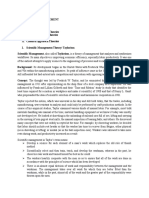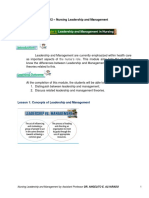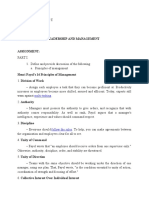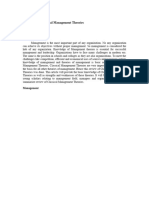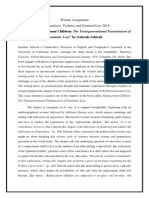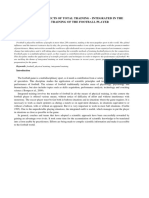Motivational Theory in Management
Motivational Theory in Management
Uploaded by
samantha_davidsonCopyright:
Available Formats
Motivational Theory in Management
Motivational Theory in Management
Uploaded by
samantha_davidsonOriginal Description:
Copyright
Available Formats
Share this document
Did you find this document useful?
Is this content inappropriate?
Copyright:
Available Formats
Motivational Theory in Management
Motivational Theory in Management
Uploaded by
samantha_davidsonCopyright:
Available Formats
Motivational Theory in Management. Transiting from theory to application & cultural hindrances to a Western approach.
The following essay will compare and contrast classical and contemporary motivational theories of management. Motivational theories of management originate from the broad category of organization behavioural management. Motivational theories are generally said to have stemmed from management theorists in the United States (Lane, Distefano & Mazneuski, 2005). This essay will also address the impediments that impact on management across National borders.
The foundations of motivational management theory address issues pertinent to employees within organizations, including but not limited to; motives, work ethics, needs, stability and intellectual stimulation (Heldman, Baca, & Jansen, 2007). As part of the complex change management approach, it is recognised that motivators in the workplace change over time.
Communication between management and subordinates is key to motivational theory success. Open lines of communication result in the dispersion of knowledge, authority and increase subordinate autonomy and supply a sense of contribution within an organization.
One of the first management theorists, Henri Fayol (1841-1925), began his management studies primarily through the mining and labour industries. He is viewed as a classical theorist, and opinion is divided on how to interpret and apply his theories. Some current researchers suggest that his approach to management lacked a humanistic approach, while others believe it utilises the correct balance of humanism and managerial superiority. Fayol remains a controversy and enigma amongst contemporary management theorists (Bagozzi, Bergami & Leone, 2003).
Fayols approach to management is in stark contrast to another theorist of his 1
time, Fredrick Taylor. Taylor had a bottom-up approach to motivation and management. By this it is meant that Taylor believed you cared for the workers first and foremost, next the task at hand, followed by supervisors and managers. Fayol on the other hand, had a top-down approach that suggested that without adequate and efficient management, neither subordinate staff or tasks at hand could function otherwise. More contemporary theorists meet on middle ground, recognising that a motivated workforce (team) is a combined effort of self-motivated staff and motivating managers (Dale, Wu, Zairi, Williams & Van Der Wiele, 2001). Regardless, both theorists agreed that managers can be made, which went against the thinking of the time, that managers are in-fact born.
Obviously what motivates subordinates and management alike is significant to the outcomes achieved within organizations. There are a variety of motivating factors that affect staff retention and high outcome achievements within organizations. It is in the interest of management to identify these stimulants within their team and to nurture and develop when required (Crawford, 2006). According to researcher Dianne Huber (2006), some of the key motivators in contemporary organizations are a pleasant work environment that provides safety and job security, the ability for staff to be challenged intellectually, adequate communication methods between management and subsidiary staff, salary, and a sense of contribution, autonomy and recognition.
It is not the purpose of this essay to transpose the above attributes into Maslows hierarchy of needs, since there is a great deal of literature available to the reader of needs as motivators. What will be said here is that ever increasingly management theorists recognise the importance of staff motivators and the direct relationship to staff performance and staff retention. Herzbergs Motivation Theory
Towards the beginning of the 1960s, a motivational approach to management 2
in organizations was developed by Herzberg (1959). Research has shown that key elements of Herzbergs approach to workplace motivation continue to be relevant today. Herzbergs theory was a two-pronged approach to motivation; firstly hygienefactors and secondly motivating factors (Gardner & Shah, . Herzbergs hygiene theory discredited much of the existing theory surrounding motivation to work at the time. This point of his theory disregarded the importance of financial gain as a motivator to work. It was found that there was a weak correlation between financial reward and sustained, motivated effort in the work place, along with a zero correlation between wage and job satisfaction. This revelation catalysed one of the most strenuously contested areas of motivational theory at the time. These findings are continually used to discredit economical rational theories to date. What was found was that the second component to motivational theory (the innate desire to perform a task well) was the primary factor in a motivated workforce. Herzbergs study inspired a plethora of replicated studies, all of which determined the original findings to be accurate. This was revolutionary in organizational approaches and conduct at the time.
In context, this theory was developed at the end of Western industrial endeavour. There was a significant drop off in the market place for on-mass produced products. Workers were beginning to inquire as to their own inherent motivators and began to seek out work that was both less repetitive and less mindless. Contemporary work practice continues to provide opportunities for innovation and creative freedom, which not only act as motivators but also provide organizations with a leading market edge. The application of these findings to applied motivation theory, is that the ability for management to recognise individual innovation within their organization, and to nurture this approach in workers distinguishes organizations that are leaders in their field from those who stagnate in out-dated motivational practices.
Cynics continue to argue that people are motivated by monetary gain and that 3
Herzbergs results may be impinged by factors such as personality and a turn in the market place, from when the study was conducted. Herzberg was given the opportunity to address critics, by going on to say that there is a distinction between motivators andmovers. Motivators were defined as deep-seated, innate longings for internal satisfaction, while movers were identified as external factors that cause transit in the workplace, whereby often a person will move to a higher paying position only when there motives arent being met. Herzberg drew from a diverse series of studies across Japan, South Africa, India, Italy and Israel, determinedly arguing that motivation originates from the need for growth, which negates the need for individuals to seek incremental incentives to drive their internal desires for accomplishment. A motivated leader is recognised as a visionary, that engages in partnership with subordinates for the greater value of both organizational outcomes and individual goals and fulfilment (Sorrentino & Higgins, 1996). Such a leader is able to identify end-points and goals, inspire effort towards achieving outcomes, discard, extend, introduce and reintroduce ideas as limitations or altered values of existing ideas become apparent. Along with these qualities, a visionary manager must recognise individual motivators of staff, maintain open means off communication and most importantly recognise future visionaries and innovators and use those people to the organizations advantage. Motivational management is a complex structure that is the leading feature of change management (including other more general management components).
Regardless of the value of theoretical motivational concepts, tangible behaviours are required to transit theory into application. The main dilemma experienced by the dedicated motivational manager, is that there are many poorly assembled motivational theories that continue to surface. The benefit of returning to the classical theorists and advocates of their approach, is that tried and tested theories can form the basis of contemporary motivational exploration.
Cross-cultural motivational management theories 4
As mentioned earlier, motivational theories pertaining to management and organizational aptitude have been largely developed in the United States. The above-mentioned motivating factors within organizational behaviour are relatively particular to the United States and Western organizational culture per-say. Cultural cognition has been an under-valued characteristic throughout motivational management theory (Steers & Porter, 1991). Motivation attributes that are socially and therefore culturally constructed, which affect the workplace include some of the following; competitiveness, engaged and disengaged emotions, autonomy, co-operative work ethic and intrinsic values that affect a persons approach to work (Weiner, Freedheim, Milton & Learner, 2003).
Where most research discusses motivational theories of management, they forget to consider the multicultural nature of the workforce, which is especially pertinent in Australia. Some of the more contemporary research into motivation concerns itself with such issues, for example Steers & Porter (1998) look at the difference between Asian and European work motivators. They found that Asian-Americans tend to perform better at workplace tasks when there is are clear management expectations placed upon the performance of and outcome of a work-related task. European-Americans on the other hand, work better towards outcomes when they are left to set their own tasks within the perimeter of managed guidelines relevant to their organizations expectations.
Concerning motivational theory another distinctive feature that is noticeable in various cultural settings is the attachment to particular emotions (Walker, Schmita & Brake, 2007). This expression and attachment to particular emotions can have a startling impact on motivational management theory when it is applied. An example of distinguishing emotional attachment is as follows; in the United States it is a given that both managers and subordinates take pride in their work. Pride within a motivational context is considered a disengaged emotion. In Japanese work culture, pride is seen as a emotion that doesnt serve the workers or the workplace. Rather a unassuming 5
approach to work is expected and is seen as a motivator, since this approach to work ethics is identified as a positive attribute.
If the above example is transposed into the applied model of the theoretical motivation approach, it means that a common Western method to motivating staff, such as positive feedback and recognition would place a Japanese worker in an uncomfortable position resulting in a reduction in intrinsic motivation (Weiner, Freedheim, Millon & Lerner, 2003).
Cross-cultural motivation theory in management is a pertinent point of further research, since multicultural workplaces are becoming the norm, and travel related work ventures into different cultures is also on the increase. It is important to recognise that what motivates on group of workers in a particular culture may disengage another group of workers elsewhere. TABLE Cultural patterns of differentiation in motivators applied in the workplace.
COUNTRY Engaged Approach Disengaged Approach Outcome in a Western (Australian) Context Deutschland Individual approach to motivation in the workplace. A high dependency on reporting individual KPIs Fits in relatively well in Australian workplace culture, although Australia tends to place more emphasis on a balance between team work and autonomy. Turkey Large focus on teamwork most tasks are approached as a group. Group work is identified as a motivator within this culture.Little relevance is given to individual KPIs. Australia places a larger emphasis on motivating the individual, which it is believed results in a conducive team with a good balance of team work and individual competitiveness. Japan Pride in the workplace is seen as a negative attribute. This impacts on the way in which staff are motivated. Friendliness is seen as the highest attribute a Japanese worker can display. In contrast to Japanese work culture, Australian Motivation Theorists place an emphasis on communication and transparency regarding staff and their ability to express 6
themselves genuinely in the workplace. Asian-Americans Perform better on tasks when the task is designed and delivered by someone other than the staff member themselves. A mix of both external and internal contribution to tasks at hand is a motivator for most Australian workers. EuropeanAmericans Are motivated to complete tasks when much of the tasks parameters are set by themselves, rather than by an external source. See above. The table above is a collection of reference material from mentioned authors, which offers a summary of cross-cultural differences in motivation in the workplace.
Conclusion
This essay has looked at both classical motivation theory and contemporary theory that aims to determine the best way to provide motivating forces to workers in organizations generally via management. The economic rationale approach is generally seen as the most flawed method of motivating in the workplace, while practices that address both management style/delivery and worker satisfaction appear to be of best value.
Pertinent to Australian work culture, the study of cultural diversity and motivation should remain a priority for researchers and theorists alike. The encouragement of tangible action based on applied theory is paramount to successfully motivating the workforce. Continued study into cultural differences is an exciting and current field of motivational science and should play a forefront role in human resource management and business studies.
References:
Bagozzi, R.P., Bergami, M., & Leone, L. (2003). Hierarchical representation of motives in goal setting. Journal of Applied Psychology, Vol 88. No. 5 pp. 915944. 7
Crawford, L. (2006) Developing Organizational Project Management Capability: Theory and Practice. Project Management Journal. August 2006. Volume, 38. No. 3, pp 74-97.
Dale, B.G., Wu, P.Y., Zairi, M., Williams, A.R.T., & Van Der Wiele, T. (2001). Total quality management and theory: An exploratory study of contribution. Total Quality Management, Vol 12. No.4. pp 439-449.
Gardner, W.L. &Shah, J.Y. Handbook of Motivation Science.
Heldman, K., Baca., & Jansen, P.M. (2007) Project Management Professional Exam Study Guide. John Wiley & Sons: NY.
Huber, D. (2006). Leadership and Nursing Care Management. Elsevier Health Sciences: US.
Lane, H.W., Distefano, J.T., & Mazneuski, M.L. (2005). International Management Behavior: Texts, Readings and Cases. Blackwell Business Press: US.
Sorrentino, R.M. & Higgins, E.T. (1996). Handbook of Motivation and Cognition: Foundations of social behaviour. Guilford Press: UK.
Steers, R.M., & Porter, L.W. (1998). Motivation and Work Behaviour. The Asia Pacific Journal of Human Resources. Volume 26.
Walker, D., Schmitz, J., & Brake, T. (2007). Doing Business Internationally. McGraw-Hill Professional: US.
Weiner, I.B., Freedheim, D.K., Millon, T., & Lerner, M.J. (2003). Handbook of Psychology and Social Psychology. John Willey & Sons: NY
Bibliography 8
Alexander Haslam, S. (2001). Psychology in Organizations: The Social Identity Approach. SAGE Publications: UK.
Bridges, W. (2003). Managing Transitions: Making the Most of Change. Nicholas Brealey Publishing: UK. Pp. 84, 153.
Burnes, B. (2005). Complexity theories and organizational change. International Journal of Management Reviews. Vol 7, issue 2, pp. 7390.
Elliot, A.J. & Dweck, C.S. (2005). Handbook of Competence and Motivation. Guilford Press: UK
Graetz, F., Rimmer, M., Lawrence, A., & Smith, A. (2006). Managing Organisational Change. Wiley Press: Australia. Pp. 276-277.
Sinclair, A. (1998). Doing Leadership Differently: Gender, Power and Sexuality in a Changing Business Culture. Melbourne University Press: Australia.
You might also like
- Co Active Coaching Fundamentals (CTI Global)Document6 pagesCo Active Coaching Fundamentals (CTI Global)Monica Dragne0% (1)
- Perpetual Mercy Hospital Swot Analysis PDFDocument6 pagesPerpetual Mercy Hospital Swot Analysis PDFStacey SalvillaNo ratings yet
- Contemporary Nursing TheoriesDocument13 pagesContemporary Nursing Theoriessagami.gNo ratings yet
- NCM 107 Activity 4-TabioloDocument5 pagesNCM 107 Activity 4-TabioloAce TabioloNo ratings yet
- Leadership and ManagementDocument23 pagesLeadership and ManagementJoanna Rose Cafirma JanorasNo ratings yet
- Scientific Management TheoryDocument2 pagesScientific Management TheoryAnonymous v5QjDW2eHx100% (1)
- H1B Visa Interview QuestionsDocument2 pagesH1B Visa Interview QuestionsRicky RicsNo ratings yet
- Albert Bandura - Toward A Psychology of Human Agency 2006Document17 pagesAlbert Bandura - Toward A Psychology of Human Agency 2006gasparixNo ratings yet
- Henry Laurence Gantt AND His TheoryDocument15 pagesHenry Laurence Gantt AND His TheoryAlain Dave100% (2)
- Management - Organization Structures and Change - Narrative ReportDocument10 pagesManagement - Organization Structures and Change - Narrative ReportRino SangariosNo ratings yet
- A Management and Leadership TheoriesDocument43 pagesA Management and Leadership TheoriesKrezielDulosEscobarNo ratings yet
- The Impact of 12-Hour Shifts On Nurses' Health, Wellbeing, and Job Satisfaction: A Systematic ReviewDocument15 pagesThe Impact of 12-Hour Shifts On Nurses' Health, Wellbeing, and Job Satisfaction: A Systematic Reviewratna220693No ratings yet
- NCM 119 Nursing Leadership and Management: Multi-TaskingDocument9 pagesNCM 119 Nursing Leadership and Management: Multi-Taskingaaron tabernaNo ratings yet
- Organizational Structure and DesignDocument6 pagesOrganizational Structure and Designrockey kcNo ratings yet
- Organizing in NursingDocument42 pagesOrganizing in NursingIvan Mendoza100% (2)
- Intergroup ConflictDocument16 pagesIntergroup ConflictMozammel HoqueNo ratings yet
- Accounting Diversity PDFDocument13 pagesAccounting Diversity PDFNico AfrizelaNo ratings yet
- Moral Deliberation and Moral DiscernmentDocument6 pagesMoral Deliberation and Moral DiscernmentGirl Lang AkoNo ratings yet
- Human Resource Management: Definition 1 - IntegrationDocument13 pagesHuman Resource Management: Definition 1 - IntegrationVivek NairNo ratings yet
- NLM Module-1Document13 pagesNLM Module-1Angel Cauilan100% (1)
- 3 Chapter V-CONCEPT-ON-ORGANIZATIONAL-MANAGEMENT-finalDocument20 pages3 Chapter V-CONCEPT-ON-ORGANIZATIONAL-MANAGEMENT-finalMariane DacalanNo ratings yet
- Leadership StylesDocument21 pagesLeadership StylesArun MozhiNo ratings yet
- Swot AnalysisDocument3 pagesSwot AnalysisMay Lj33% (3)
- Centralized and Decentralized Organizational Structures 2Document3 pagesCentralized and Decentralized Organizational Structures 2VivekNo ratings yet
- Performance Appraisal Case StudyDocument2 pagesPerformance Appraisal Case StudyCrystal MugfordNo ratings yet
- Malaybalay City, Bukidnon: Bukidnon State University College of NursingDocument3 pagesMalaybalay City, Bukidnon: Bukidnon State University College of NursingJune Bars100% (1)
- Lewin's 3 Step TheoryDocument7 pagesLewin's 3 Step TheoryJames Fulton Ragay VillahermosaNo ratings yet
- Leadership - Taberna, Catherine TDocument12 pagesLeadership - Taberna, Catherine Taaron tabernaNo ratings yet
- Nursing Management Process and FunctionsDocument151 pagesNursing Management Process and FunctionsYum CNo ratings yet
- Chapter - 1-Notes PDFDocument12 pagesChapter - 1-Notes PDFMesay BarekewNo ratings yet
- The Role of Nursing Informatics On Promoting Quality of Health Care and The Need For Appropriate EducationDocument7 pagesThe Role of Nursing Informatics On Promoting Quality of Health Care and The Need For Appropriate EducationBasrin NasirinNo ratings yet
- Leadership & Mgt.Document21 pagesLeadership & Mgt.Abhijit DeyNo ratings yet
- Chapter 5 - Group DynamicsDocument7 pagesChapter 5 - Group DynamicsLord GrimNo ratings yet
- Stages of AdoptionDocument23 pagesStages of AdoptionAnurag Shankar SinghNo ratings yet
- Precede ProceedDocument5 pagesPrecede Proceedemmet11100% (3)
- Drug StudyDocument9 pagesDrug StudyShiara Ruth EdrosoloNo ratings yet
- PlanningDocument2 pagesPlanningEenagaraniki EmaindiNo ratings yet
- NLM - DirectingDocument8 pagesNLM - DirectingNa NaNo ratings yet
- Unit IV Power & Politics in NursingDocument18 pagesUnit IV Power & Politics in NursingSHAFIQNo ratings yet
- Final Exam Phil 447 Logic and Critical ThinkingDocument7 pagesFinal Exam Phil 447 Logic and Critical ThinkingTommie100% (2)
- Management and Theories of Management NotesDocument11 pagesManagement and Theories of Management NotesjosephNo ratings yet
- Maam Gail M9 - Continuing Professional Devt (But M10 in MarilagDocument39 pagesMaam Gail M9 - Continuing Professional Devt (But M10 in MarilagxtnreyesNo ratings yet
- Research Final DefenseDocument67 pagesResearch Final DefenseNellyWataNo ratings yet
- Chapter ThreeDocument8 pagesChapter ThreeasheNo ratings yet
- Types of Leader-WPS OfficeDocument17 pagesTypes of Leader-WPS OfficeMaryam Kainat0% (1)
- Cognotive Factors of LeadersDocument3 pagesCognotive Factors of LeadersMuhammad Hashim MemonNo ratings yet
- 3136 - OA - Motivation Among Nurses PDFDocument6 pages3136 - OA - Motivation Among Nurses PDFShahnaz DarNo ratings yet
- NCMA110: 1. Eriksson, Watson and Benner 2. Rogers and Orem 3. Johnson, Roy and NeumanDocument31 pagesNCMA110: 1. Eriksson, Watson and Benner 2. Rogers and Orem 3. Johnson, Roy and NeumanMarian TorresNo ratings yet
- Theories of Leadership and ManagementDocument55 pagesTheories of Leadership and ManagementClaire Maurice JuaneroNo ratings yet
- StaffingDocument15 pagesStaffingsalisheyn200910391No ratings yet
- STAFFINGDocument18 pagesSTAFFINGKrishnaNo ratings yet
- She Believed That in The Nurturing Environment, The Body Could Repair ItselfDocument7 pagesShe Believed That in The Nurturing Environment, The Body Could Repair ItselfMegan N. ReyesNo ratings yet
- Handouts in NCM 119Document6 pagesHandouts in NCM 119Meliza BancolitaNo ratings yet
- Principles of MNGT QuizzesDocument16 pagesPrinciples of MNGT QuizzesCharles DebrahNo ratings yet
- Motivational TheoriesDocument67 pagesMotivational TheoriesShabbir BilalNo ratings yet
- Humanbe Midterm ReviewerDocument11 pagesHumanbe Midterm ReviewerLove Glenhir MestidioNo ratings yet
- Nursing Theory AssignmentDocument7 pagesNursing Theory Assignmentapi-315295712No ratings yet
- Mcgregor'S Theory X and Theory YDocument11 pagesMcgregor'S Theory X and Theory YMuhammad MurtazaNo ratings yet
- Personality Development ReportDocument3 pagesPersonality Development ReportRishabh JainNo ratings yet
- Johari Window With ExamplesDocument24 pagesJohari Window With ExamplesJotinWahengbamNo ratings yet
- Ethical Leadership & Whistle BlowingDocument10 pagesEthical Leadership & Whistle BlowingSaf Wan100% (1)
- Classical and Human Relations Approach To ManagementDocument9 pagesClassical and Human Relations Approach To ManagementMC SimelaneNo ratings yet
- Organisation Behaviour EssayDocument15 pagesOrganisation Behaviour EssayMarian NeaguNo ratings yet
- Is The Notion of Bhutan As An Ethical Utopia Misleading (Proper)Document5 pagesIs The Notion of Bhutan As An Ethical Utopia Misleading (Proper)samantha_davidsonNo ratings yet
- ACPMH Track Record: Client Case Study: Client: Department of Veterans' Affairs (DVA)Document1 pageACPMH Track Record: Client Case Study: Client: Department of Veterans' Affairs (DVA)samantha_davidsonNo ratings yet
- Canadian Strategies:: Instructor-Led Training (ILT)Document1 pageCanadian Strategies:: Instructor-Led Training (ILT)samantha_davidsonNo ratings yet
- The God HelmetDocument5 pagesThe God Helmetsamantha_davidson100% (1)
- The Self As Cognitive ConstructDocument10 pagesThe Self As Cognitive ConstructClairee Yu100% (3)
- MGMT 625 Change ManagementDocument71 pagesMGMT 625 Change ManagementMrs.Tariq Khan100% (2)
- Charlotte Bronte and The Consistency of MindDocument5 pagesCharlotte Bronte and The Consistency of MindAnnie DuongNo ratings yet
- Suprising Truths About MotivationDocument2 pagesSuprising Truths About MotivationMarivic DianoNo ratings yet
- Countable and Uncountable NounsDocument27 pagesCountable and Uncountable NounsJordana González Sánchez100% (2)
- Problem and Solution Trees!Document17 pagesProblem and Solution Trees!levibro guyNo ratings yet
- Cultural Geography III: Objects of Culture and Humanity, Or, Re - Thinging' The Anthropocene LandscapeDocument9 pagesCultural Geography III: Objects of Culture and Humanity, Or, Re - Thinging' The Anthropocene Landscapeanon_418824458No ratings yet
- Neuromarketing EssayDocument3 pagesNeuromarketing Essayjorge jmzNo ratings yet
- The Fine Line Between A Bribe and A Gift-Ayush JamesDocument6 pagesThe Fine Line Between A Bribe and A Gift-Ayush JamesmedilaceNo ratings yet
- Hal Foster Vision and Visuality Discussions in Contemporary Culture PDFDocument75 pagesHal Foster Vision and Visuality Discussions in Contemporary Culture PDFEd GomesNo ratings yet
- Sandplay Therapy An Overview of Theory, Applications - C.roesLERDocument38 pagesSandplay Therapy An Overview of Theory, Applications - C.roesLERRaluca Ciochina100% (1)
- Introduction To Accounting Theory (1.2)Document39 pagesIntroduction To Accounting Theory (1.2)ika_simple89No ratings yet
- FCE Writing Part 2 Articles: TitleDocument6 pagesFCE Writing Part 2 Articles: TitleInma Llopis TerolNo ratings yet
- Study VisitDocument400 pagesStudy VisitCristinaNo ratings yet
- Analysis of "Replacement Children: The Transgenerational Transmission ofDocument5 pagesAnalysis of "Replacement Children: The Transgenerational Transmission ofArshiyaNo ratings yet
- Turning The Mind Into An Ally OneDocument3 pagesTurning The Mind Into An Ally OnesengcanNo ratings yet
- Econometrics SyllabusDocument4 pagesEconometrics Syllabusgray skyNo ratings yet
- Prepare 5.0 Marital TestDocument19 pagesPrepare 5.0 Marital TestsnailbookNo ratings yet
- Stuart Kauffman's Adjacent Possible TheoryDocument2 pagesStuart Kauffman's Adjacent Possible Theorychaoxian82416No ratings yet
- BisexDocument44 pagesBisexSomesh Jaiswal0% (1)
- VinnieDocument7 pagesVinnieNaftaliNo ratings yet
- IELTS Academic Level 3: Unit 1 Live and LearnDocument15 pagesIELTS Academic Level 3: Unit 1 Live and LearnOtz StefNo ratings yet
- Sample Question - Competency MappingDocument2 pagesSample Question - Competency Mappingpaulo_fanNo ratings yet
- EthnographyDocument5 pagesEthnographyapi-272842691No ratings yet
- Self Disclosure and Self Awareness 111Document56 pagesSelf Disclosure and Self Awareness 111Hamss Ahmed100% (1)
- Professional EtiquetteDocument25 pagesProfessional EtiquetteNitika Puniani SahniNo ratings yet
- ArticolDocument2 pagesArticolAdinaAndreeaDreveNo ratings yet





